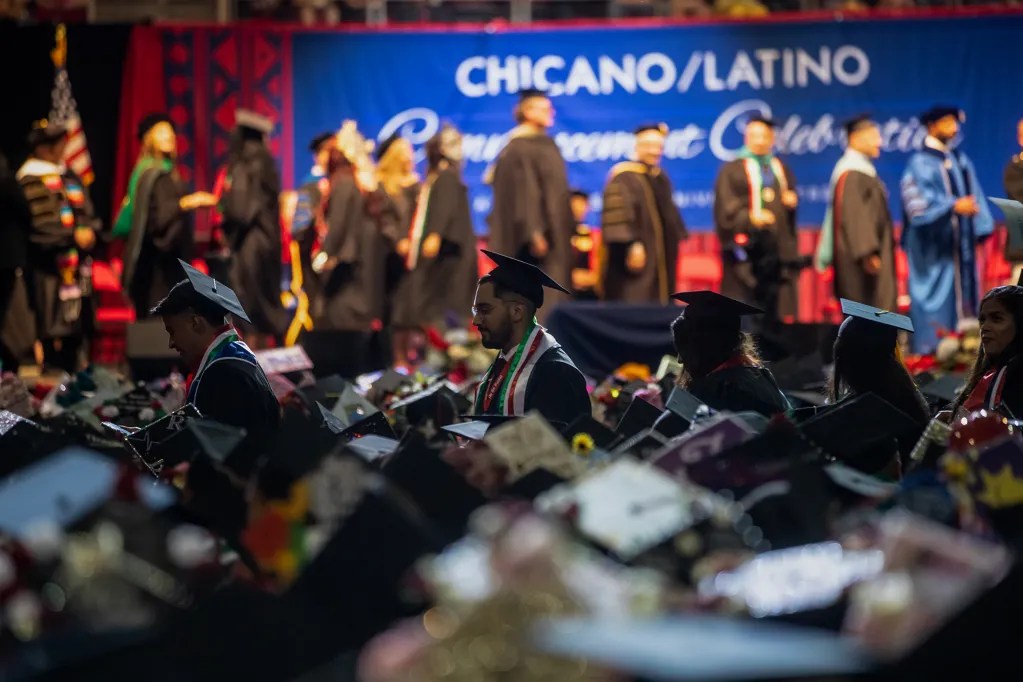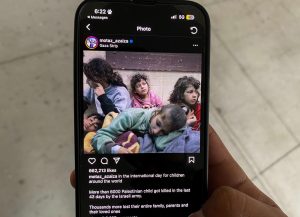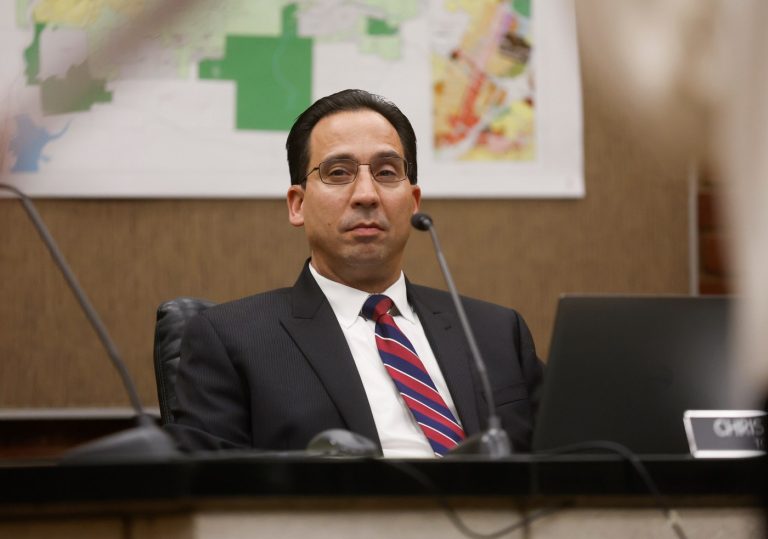BY JACQUELINE MUNIS | CalMatters
Nearly 3.7 million students and 667,000 newborns in California have money invested in a savings account to help pay for college. But most families don’t know the money is there.
Citlali Lopez, a second-year psychology student at Sacramento State, found out a few months ago she had $500 sitting in a California Kids Investment and Development Savings Program (CalKIDS) account. Although she’s been eligible to use the funds since she graduated high school in 2022, she had no idea until her sister, who works at a nonprofit that supports low-income students with scholarships and financial aid, told her to check her eligibility. Lopez was skeptical at first, but found she was eligible and registered her account.
“I was just really surprised that I was able to get some extra help,” she said.
Financial aid had been top of mind for her and guided her decision to go to Sacramento State. She plans on using the money to finish general education classes over the summer if financial aid will not cover it.
Citlali Lopez is a second-year student at Sacramento State University and a beneficiary of the state’s CalKIDS program. May 9, 2024. Photo by Miguel Gutierrez Jr., CalMatters
So who gets money? Under CalKIDS, all babies born in California receive a sum. Babies born between July 1, 2022 and June 30, 2023 received $25 deposits, and all babies born after July 1, 2023 receive $100 deposits.
As part of the program, all low-income first grade students receive a one-time deposit of $500. First-graders who are in foster care receive an extra $500 and homeless first-graders receive $500 more, totalling $1500 for some students. All the accounts are tax-free, and the money is invested whether or not families claim their accounts.
Additionally, the state spent $1.8 billion in the 2021-22 budget to provide a one-time deposit to all low-income students in grades 1 through 12 in 2022.
Yet, of the 4.3 million student accounts created, only 313,445 accounts have been claimed by families, meaning they have registered online and seen the amount in their accounts. Only 6.3 percent of newborn accounts have been claimed and 7.4 percent of student accounts have been claimed as of March 2024.
The state is slowly building awareness about college savings
CalKIDS is run by a three-person team led by Julio Martinez, the executive director of the Scholarshare Investment Board, an agency within the State Treasurer’s Office. It administers the state’s 529 college savings accounts, which allow families to invest money tax free to cover education related expenses in the future. The team is responsible for creating the accounts, notifying families about the accounts and explaining what CalKIDS can provide to families.
“With these programs, it takes time to kind of build brand awareness, and also to break down the skepticism that often exists when you get a letter in the mail that says you have free money,” Martinez said. CalKIDS staffers go to college fairs and financial aid nights and host online informational sessions to reach families and students.
The state allocated $22 million in the 2022 and 2023 budgets to market the program. In Los Angeles, Riverside, Fresno, and Sonoma counties, CalKIDS program info is sent to all families that request a birth certificate, according to Joe DeAnda, the director of communication at the State Treasurer’s Office. During the first three months of this year, registration in the newborn program has more than doubled, from 20,608 to 42,312 newborns.
In April, CalKIDS began targeting high school seniors, through social media, email and direct mail, according to DeAnda. By May, the number of claims among high school seniors increased by 74%. They have partnered with school districts, such as Hawthorne School District in Los Angeles County, where 87% of seniors have claimed their accounts.
Still, most of the funds for marketing CalKIDS remain unused. The 2023-24 California state budget reappropriated $8 million to CalKIDS for a statewide media campaign, and the Scholarshare Investment Board is currently soliciting proposals for marketing services, which were anticipated to start on April 1, but have not begun.
“If families are not aware of this program, then it’s not going to have the impact that we think it’s going to have,” Martinez said.
The fact that many families don’t start thinking about college until high school is one cultural obstacle that college savings programs like CalKIDS run up against, says Willie Elliott, a professor of social work and founder of the Center on Assets, Education, and Inclusion at the University of Michigan.
“So, we can’t expect that we put one of these programs in place, and, instantly, people get it and start functioning in that way,” Elliott said.
Elliott has helped develop state and local college savings programs in Pennsylvania, New York City and Washington, D.C. He says that enrollment is not the best measure of success of programs like CalKIDS, especially this early on in the program.
“What you have in place in California is the infrastructure and now you have to do the work of making communities aware,” Elliott said.
He suggests that creating a culture around college savings through programs like CalKIDs will lead to positive outcomes. Those include increased account enrollment, more family conversations about going to college, and generally less stress for families who will be hopeful for their children’s future.
The conversations about college are as important as the amount of money actually in the account, Elliott said. Elliott’s research has shown that low-income students with a college savings account are three times more likely to attend college and four times more likely to graduate than students without an account.
A screenshot of the CalKIDS website. Image via CalKIDS
Amanda Cook, a mother of six who has four children eligible for CalKIDS, is the homeless student advocate at Marysville Joint Unified School District in Yuba County, where she works to support homeless students and help them graduate. She said a lot of the families she works with don’t have college at the top of their mind because they’re thinking about urgent concerns like where they will sleep.
She said if schools were able to register students, it would be helpful for the families she supports. She also said training for school staff and counselors on the program as well as outreach from California Health and Human Services would help build awareness for schools and families.
CalKIDS joins local programs investing in students’ education
Related Articles
Police in riot gear surround Israel-Hamas war protesters at UC Santa Cruz. Arrests reported
Coroner: Son of former YouTube executive died from accidental drug overdose in UC Berkeley dorm
Still waiting on financial aid offers? Here’s what you can do now
State Assembly approves streamlining West Valley College tuition waiver
UC student workers expand strike to two more campuses
For many students, CalKIDS can be coupled with one of more than a dozen local child’s savings account programs in California. Launched in 2010 by then-mayor of San Francisco Gavin Newson, Kindergarten to College was the first program in the country to include automatic and universal enrollment.
Over the last 14 years, the program has been able to refine its outreach efforts to meet the needs of San Franciscans, said Amanda Fried, the chief of policy and communications at the San Francisco Office of the Treasurer & Tax Collector. Students are eligible no matter their documentation status and can easily make cash deposits into their accounts.
“People have so many things on their plate, and so many competing priorities, and I think a huge mistrust of the financial system, which is totally warranted,” Fried said. “So this program just kind of eliminates so many barriers for families.”
The program’s five-person team hosts weekly online office hours in English and Spanish, texts resources and reminders to parents and trains teachers and counselors as school ambassadors to explain the program and answer questions. Students take field trips to Citibank to make deposits into their accounts, so they can physically contribute to their futures.
“We really have an intentional focus on schools where typically students are much less likely to go to college. That’s where we focus our in-person resources,” Fried said. ”We’re on the ground at those schools, talking to families constantly.”
Oakland Promise has a child’s savings program that starts in kindergarten, also called Kindergarten to College, alongside a program for newborns for Medi-Cal eligible families called Brilliant Baby. Veena Pawloski, the chief program officer at Oakland Promise, said they use community-based organizations to act as enrolling partners.
Can college savings accounts help combat poverty?
The aim of college savings programs like CalKIDS is not for money deposited by the state to grow enough to pay for college entirely. Rather, the program intends to ease some of the burden of college costs and help students create a college-bound identity.
Last year, UCLA opened the CalKIDS Institute in partnership with the state to boost outreach as well as research the program’s reach and which demographics they should be targeting based on enrollment. The institute’s director, Nayiri Nahabedian, said that, ultimately, the point of all these programs is to make college seem like an attainable goal for students and show them that the state, their community and their family believe that they can pursue higher education.
“CalKIDS made me realize more how much people are willing to help students,” said Lopez, the Sacramento State student.
“For a lot of students [the money] can make the difference between deciding to go and not deciding to go. It can be the difference between having a laptop and not having a laptop, having WiFi at home and not having WiFi at home,” Martinez said.
Recent graduates walk up the Hilmer Lodge Stadium ramp, while students take selfies after recieving their associates degrees at Mt. San Antonio Community College’s 75th commencement ceremony, on June 11, 2021. Pablo Unzueta for CalMatters
In addition to registering, students can connect their CalKIDS account to a ScholarShare 529 account where families can contribute their own money, which is invested. Six percent of claimed student accounts and 35% of claimed newborn accounts have been connected to a ScholarShare 529 account. According to Martinez, families have, on average, $2,890 in their Scholarshare 529 account connected via their CalKIDS account.
Evelyn Garcia Romero, a senior at Calistoga Junior-Senior High School, did not know before talking to CalMatters that she could add her own money into a Scholarshare 529 that has accrued $32 in addition to the original $500 deposit.
“I feel like every cent counts and makes a difference,” said Garcia Romero, who plans on using her CalKIDS money and future savings to go to law school. “So, having an extra $500 would be so helpful and will definitely encourage me to attend college even more.”
Resources
See if you or your child is eligible
Claim your CalKIDS account
Get answers to frequently asked questions
Contact CalKIDS for help
Munis is a fellow with the College Journalism Network, a collaboration between CalMatters and student journalists from across California. CalMatters higher education coverage is supported by a grant from the College Futures Foundation.












